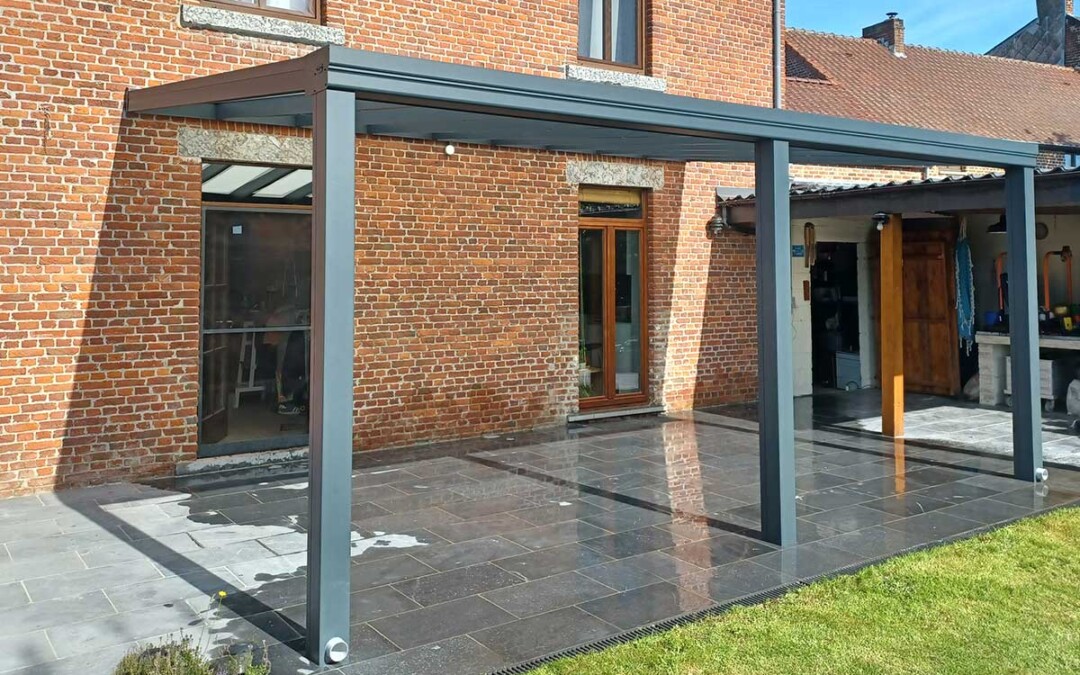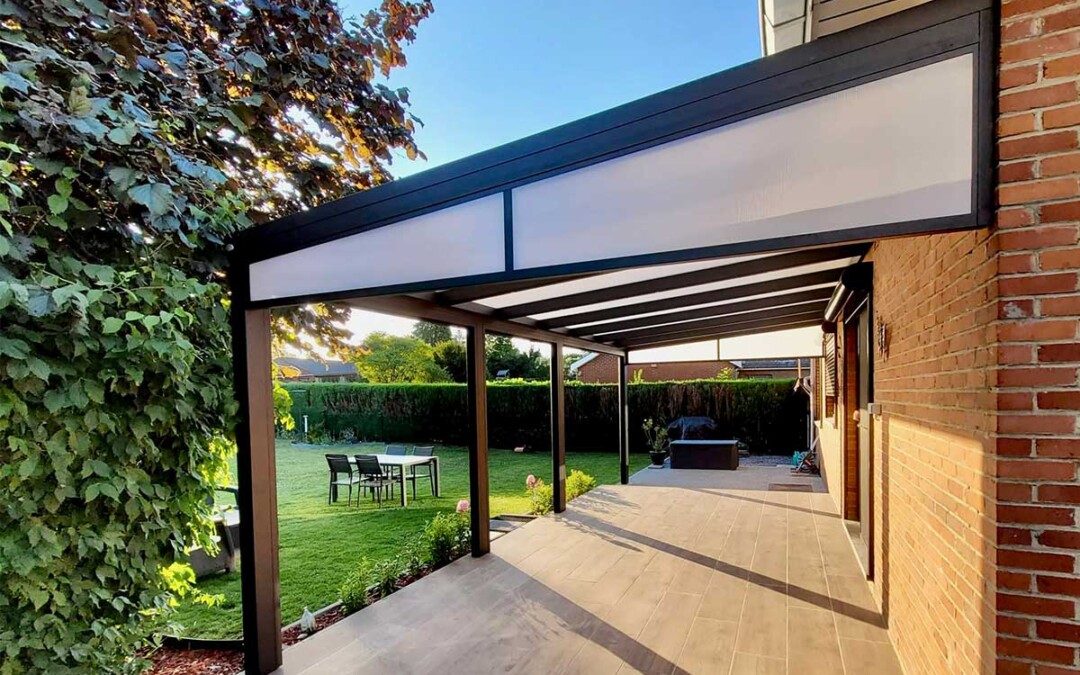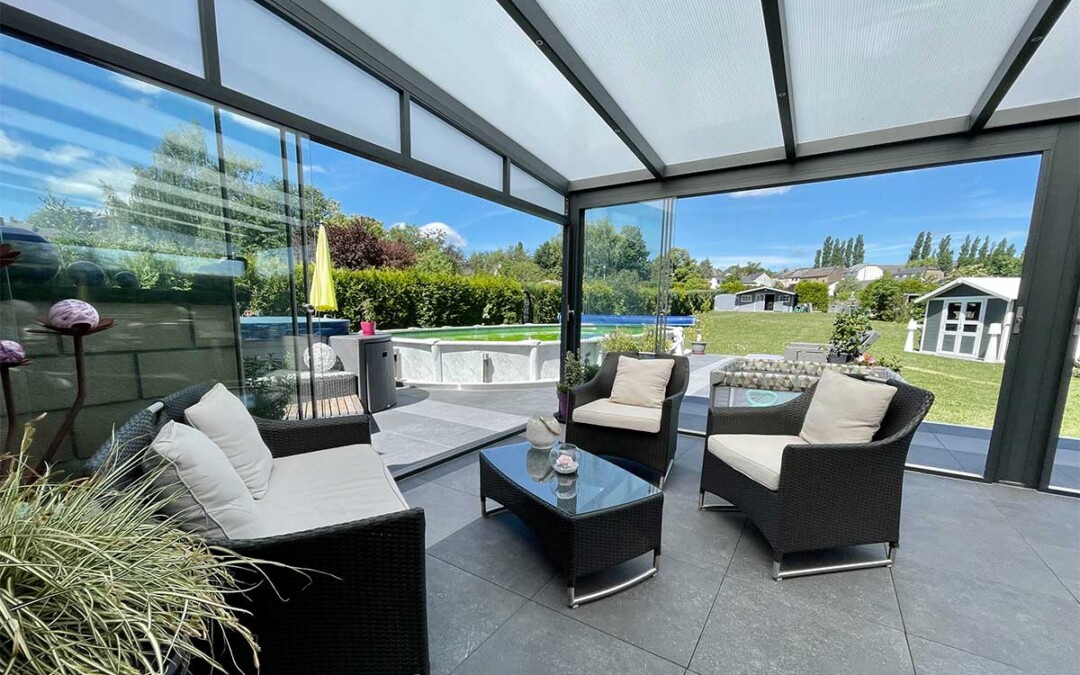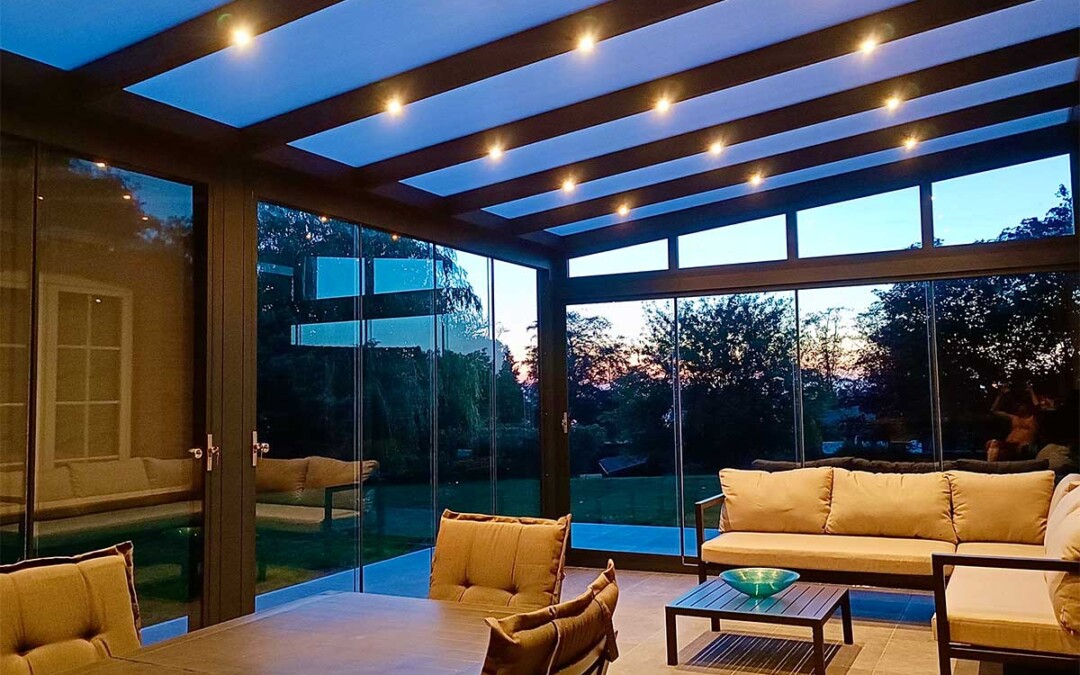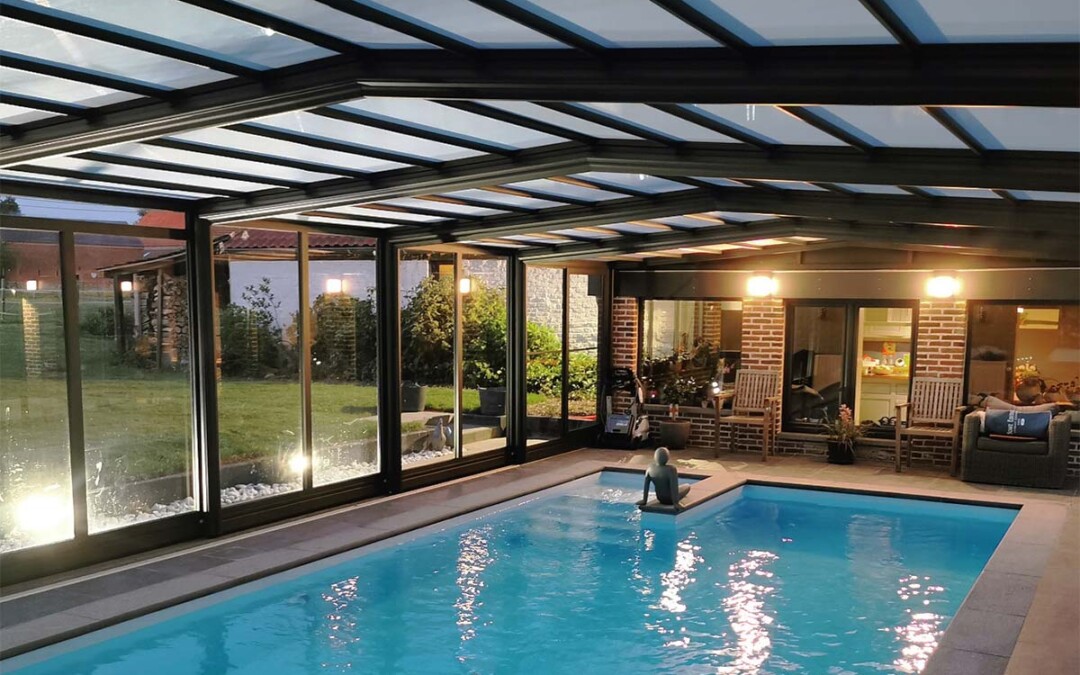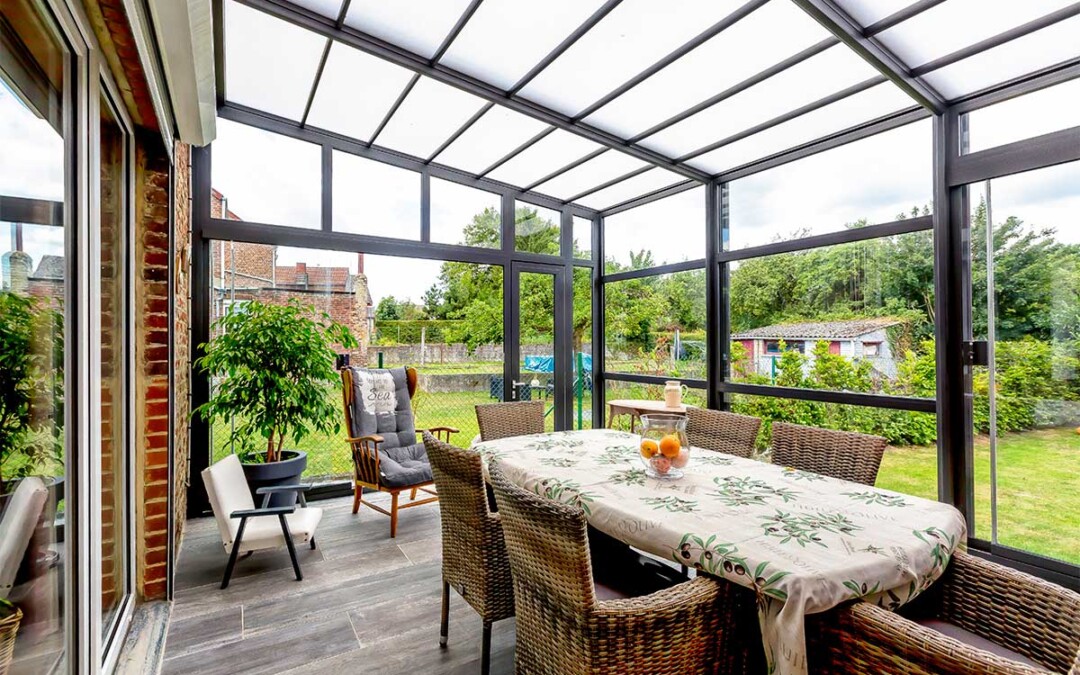Tips for use and care
Discover essential advice on the care and use of Verandair products! You guarantee the longevity and efficiency of our patio and pool enclosures.
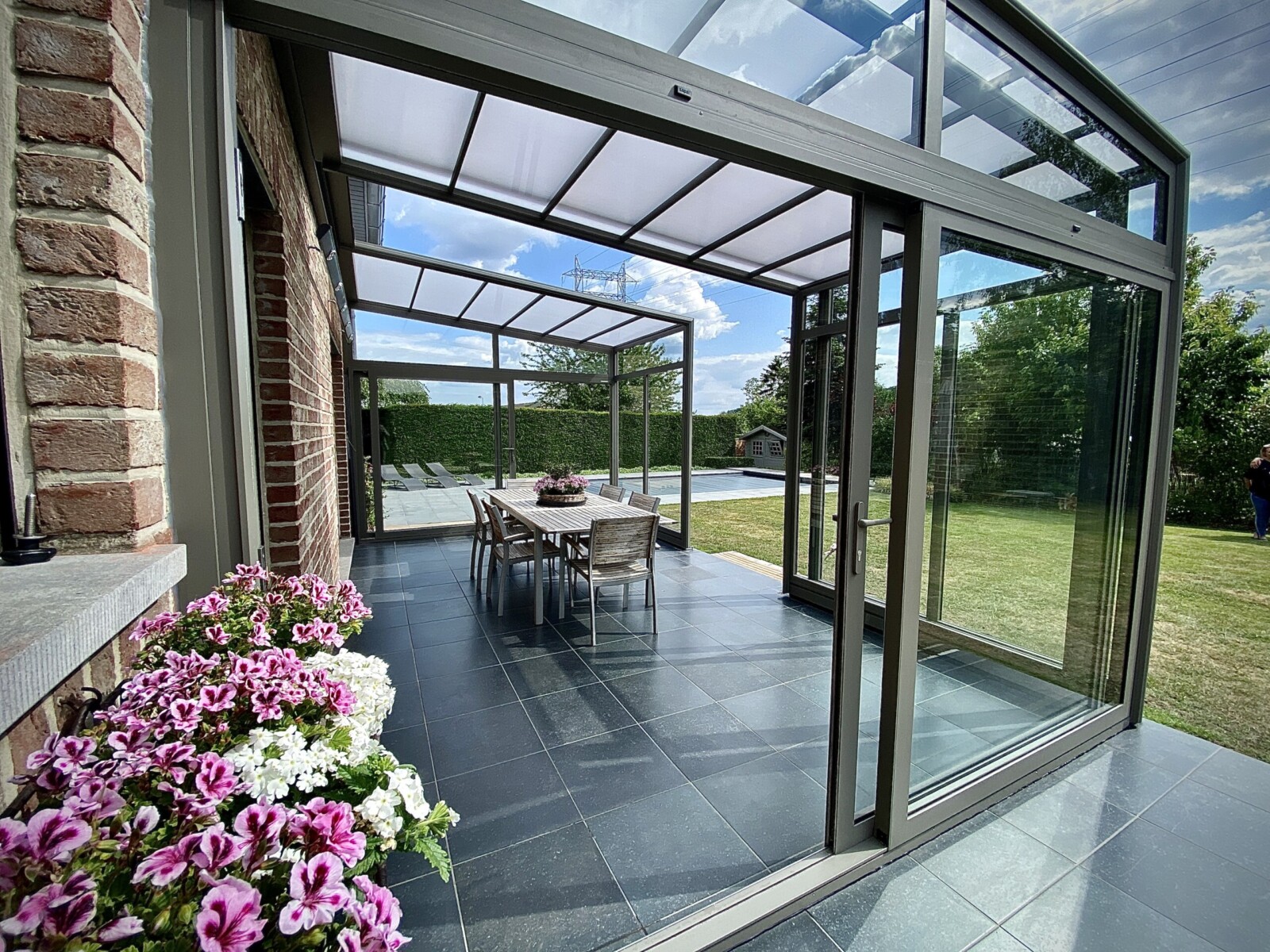
Opening and closing the shelter
Make sure there are no obstacles in the way of opening or closing the enclosure. The floor surface must always be clean, level and even to ensure proper operation of the enclosure.
To open, unscrew the anchors holding the shelter to the ground (except those on the fixed element).
Opening the retractable enclosure generally requires the use of 2 people, whatever the type of shelter. In the case of a wall-mounted shelter (which slides along a wall), you'll need an additional pole.
Perfect guidance does not exist in this type of installation. It is therefore likely that your shelter will not line up exactly opposite its initial anchors when it is fixed to the ground. All you have to do is manipulate the shelter to match the mounting holes to the anchors.
We recommend the use of a small ground guide profile under the first sliding element of your enclosure, to optimize its guidance.
Cleaning - maintenance
VERANDAIR® shelters are designed to last for many years, provided they are properly maintained.
The frequency and intensity of cleaning are determined by the nature of the ambient pollution. (rail traffic, industrial zones, proximity to the sea, nearby construction sites, etc.) and left to the customer's discretion. In practice, we recommend that you clean your shelter at least two to four times a year.
The conditions under which your shelter is cleaned must not cause any damage to the structure or its surroundings. Check whether the products used have no adverse effects on materials that make up your shelter. If you're using a ladder, be sure to protect its support ends. We recommend using a ladder without direct contact with the work.
Preferably use clean, slightly damp microfiber cloths. As far as possible, avoid using a scraper, especially a metal one. However, if you can't do otherwise, make sure that no rigid metal parts come into contact with the glazing, gaskets and aluminum profiles, and that no dust particles get caught under the squeegee blade.
Do not use detergents. Never use solvents or scouring agents. Use neutral soap flakes (pH value between 6 and 8). Next, rinse thoroughly using a water jet directed from top to bottom. Do not wipe dry (risk of scratching).
Cleaning must not be carried out at outside temperatures above 25°C and below 10°C. Do not clean the shelter in direct sunlight.
Using a silicone spray, lubricate rails, slides and locks whenever necessary, to facilitate overall system operation.
Clean your gutters regularly to prevent water from overflowing onto the roof of your patio cover. It is strictly forbidden to step on or place any heavy object on the shelter (risk of deformation, scratches).
Do not use high-pressure cleaners or steam cleaners. There's a significant risk of water infiltrating into the roofing panels and damaging the silicone seals.
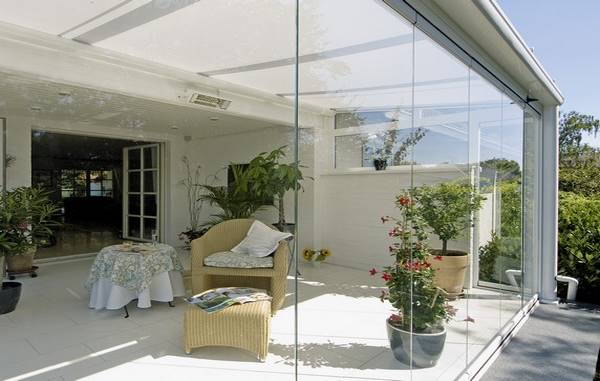
Condensation inside the patio cover
Condensation may appear in your patio/pool enclosure. Condensation is nothing more than moisture seeking a way out in the process of cooling warm air. The warm air will deposit the excess humidity in the coldest part of the room. In most cases, this will be on the vertical glass walls and/or polycarbonate roof.
Better ventilation reduces humidity. Ambient humidity should be between 45 and 55%. Above this humidity level, the room needs to be ventilated to bring in as much fresh, healthy, dry air as possible.
Modern homes are often equipped with a crawl space. This is located under the floor of the building and prevents the risk of humidity, particularly in the event of heavy rain. Ventilation of the crawl space is mandatory. However, to avoid condensation caused by rising damp, make sure to isolate the crawl space from the volume of your shelter.
Electrical equipment in the patio enclosure
To ensure your safety inside your patio enclosure, only electrical appliances and equipment with an IP64 protection rating (international standard) are permitted inside the enclosure.
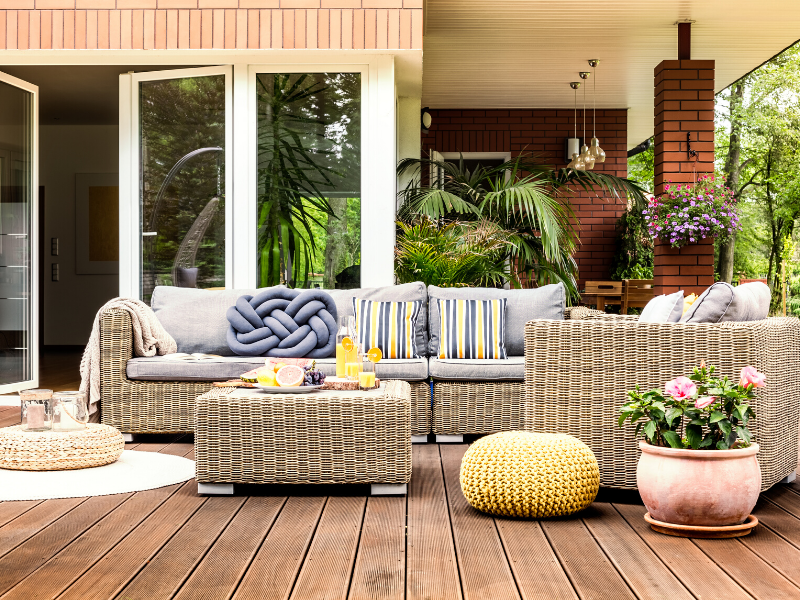
Furniture and other fittings in the patio enclosure
Only garden furniture and materials intended for outdoor use are suitable for your shed.
Never install furniture or other accessories against the glass.
Pool enclosure maintenance tips
1. CONCEPT OF YOUR POOL ENCLOSURE
You have just purchased a pool enclosure manufactured by VERANDAIR®.
The special feature of your mobile enclosure, the ideal complement to your pool, is that it's telescopic and opens manually. It falls into the category of light-structured pool enclosures, the whole being considered removable and dissociable from existing structures and considered as movable property.
In addition to off-season swimming, it improves the cleanliness of your pool and its immediate surroundings and, when closed, ensures the safety of your children.
These instructions cover the description, use, safety, maintenance and warranty of VERANDAIR® shelters.
2. DESCRIPTION
Precise specifications and dimensions are given in the order confirmation before production begins.
3. RECOMMENDATIONS
3.1. Given its width, your shelter can support a maximum snow weight of 60 kg per m². To withstand such an overload, the shelter must be anchored to the ground. In the event of heavy snowfall, it is essential to clear the snow, especially as it may be "wet" and/or frozen. To avoid snow accumulation, you can also maintain a constant temperature of 12° inside the shelter.
3.2. Your shelter can withstand a maximum wind speed of 100 km/hour, provided the openings are locked and the ground anchors are secured. For wind speeds in excess of 100 km/h, we recommend the use of cables, straps, etc. to secure the shelter to anything that can withstand these wind speeds (wall, house, rock, etc.). We would like to remind you of the importance of taking out storm, snow, hail and natural disaster insurance.
3.3. Ground anchors must be set in a concrete footing at least 15 cm deep.
4. DIRECTIONS FOR USE
The pool can be a serious hazard for your children. Drowning can happen very quickly. Children near a swimming pool require your constant vigilance and active supervision, even if they know how to swim. Learn life-saving gestures.
Memorize first-aid numbers and post them near the pool.
For France :
Fire department: 18
SAMU: 15
Or 112
The number of your local poison control center
For Belgium :
112
The number of your local poison control center
4.1. Pool enclosure in closed "safety" position
Your shelter is designed to protect children under 5 from drowning, but it's no substitute for common sense and individual responsibility. Nor is it intended to replace the vigilance of parents and/or responsible adults, who remain the essential factor in protecting young children.
When closed, the shelter will be inaccessible to children provided that :
- access doors locked and keys removed from locks.
- the hinged or accordion front is locked.
- the first moving part (usually the smallest) is locked to the floor with knurled screws and knobs.
- the last fixed element (generally the largest) is fixed to the floor with fixings that can only be removed using a tool.
4.2. Opening the pool enclosure
2 people are ALWAYS required to open the retractable enclosure or veranda. Without motors, it's impossible to guarantee that the pool enclosure can be opened and closed by just one person, whatever the type of enclosure.
Make sure that the guide grooves on the shelter's bottom rails and/or the floor guide rails are clean, and clear the inner and outer floor surfaces near the shelter walls. The ground surface must be flat and even to allow the shelter to function properly.
Unscrew all knurled knobs holding the shelter to the ground (anchoring points) except those on the fixed element.
Generally speaking, it's much easier to open or close a shelter when the door(s) are open to release the air inside.
If there are obstacles around your pool under the shelter (ladder, diving board, buoys, table, chairs, deckchairs, etc.), unlock and tilt the front panel provided for this purpose. Please ensure that the front panel is locked in the horizontal position, or open in the case of folding front panels.
Don't let anyone lean, hang or swing from the facade.
After opening (or tilting) the façade, two adults push on the 2 uprights of the moving element furthest away from the fixed element with equal force, so that the elements align with the fixed element. Make sure there are no obstacles in the way. Make sure no one is in the area of the moving shelter.
If the front panel is tilted, it must be returned to the vertical position. If you wish, you can then telescope it to the bottom of the elements, freeing up space inside the shelter.
You can now enjoy your open-air pool to the full, but be careful with children playing around the pool, as a folded enclosure no longer ensures pool safety.
As soon as you've finished swimming, close your cover - it only takes a few moments and your pool is safe again.
4.3. Closing the pool enclosure
Return the front panel to the front of the element if it has been telescoped, tilt it if necessary to avoid obstacles, and always lock it securely.
Make sure there are no obstacles in the way.
Two adults grasp the vertical uprights of the first movable element and pull it with equal force to the right and left of the shelter, to prevent it from getting in the way.
When all the elements are deployed on the basin :
- return the front panel to its vertical position or close the folding front panel
- secure the shelter with the floor fixings provided. Install the front security locks
- lock doors
- remove keys and store them so that they are inaccessible to small children
Do not let anyone step on the shelter. Do not place heavy objects on the shelter (risk of deformation, scratches).
5. MAINTENANCE AND CLEANING OF YOUR POOL ENCLOSURE
To keep your shelter in good condition and ensure its longevity, we recommend 2 servicing intervals per year. This involves washing the inside and outside walls. We recommend using a telescopic broom with cotton bristles and a mild liquid soap. Then rinse thoroughly.
Avoid abrasive products, which may damage the surfaces of the shelter materials. Using a rubber squeegee can cause scratches if it is in poor condition.
Use a silicone spray to grease locks whenever necessary, to facilitate key operation.
If you use a high-pressure system to clean the enclosure, be sure to direct the jet in accordance with the instructions below to avoid introducing water into the roof panel cavities.
6. MAINTENANCE
Wear parts (guide rollers, castors, locks, etc.) must be checked regularly (1x/year). Spare parts must be genuine.
In the event of a malfunction preventing the pool from being closed and secured, or if the equipment is temporarily unavailable, take all necessary measures to prevent access to the pool by young children, until the shelter is repaired.
FAQ
ANSWERS TO THE QUESTIONS POSED.
When the shelter is in operation, the mounting brackets do not fall down in front of the ground anchoring holes.
This delay is due to the lack of synchronization of the 2 people who maneuvered the shelter. To remedy this problem, simply start again by correcting the trajectory.
Tip: When moving, use the edge of the coping or a row of slabs as a reference point.
Note that if weather conditions allow (no wind, snow), it's not essential to replace all ground fasteners every time you maneuver. Those of the 2 end elements may suffice, but are necessary.
I have condensation inside my shelter
This is a perfectly normal phenomenon, caused by contact between the warm, humid atmosphere inside the shelter and the more or less cold wall in contact with the outside. All materials and components are designed to withstand a damp atmosphere.
Transparent panels tend to bulge inside the enclosure
The polymethylmethacrylate fillings that make up the transparent parts of your shelter are "hydrophilic": they absorb water according to the relative humidity of the air, and expand or shrink according to this humidity. This phenomenon can also be increased by the difference in dilatation in the thickness of the material when outside and inside temperatures are different. These phenomena are normal.
Are roofing panels hail-resistant?
The roofs of our shelters are made of honeycomb polycarbonate, a material that is both flexible and extremely impact-resistant. We would remind you, however, that it is necessary to take out insurance against damage caused by exceptional weather conditions.
I have moisture at the end of the roof plates.
The polycarbonate cells at the ends and junctions may fill with water or form droplets. This is a natural phenomenon, due to the porosity of polycarbonate and the condensation of water contained in the alveolar air. This phenomenon is normal.
Green or brown spots form inside my shelter.
Given the high humidity inside the shelter, and without sufficient ventilation, algae may appear in certain places on the aluminum profiles, particularly during winter. This in no way alters the quality of the product.
Tip: Before winter, spray profiles with a mixture of water and anti-algae product.
Opinions and testimonials
